The Studio Technologies Model 74/75 Surround Monitoring System combines the StudioComm for Surround Model 74 Central Controller and Model 75 Control Console to provide 5.1 surround and stereo source monitoring capabilities, along with a full-featured headphone talkback cue system.
The Studio Technologies Model 74/75 Surround Monitoring System is a perfect fit for contemporary facilities that need to perform a variety of audio tasks. These can include surround and stereo mixing and monitoring, live recording of voice, music, and sound effects, and on-air broadcast applications. The Studio Technologies Model 74/75 Surround Monitoring System's features were carefully selected to provide extensive capabilities while remaining simple to operate. Of overriding concern is maintaining the quality of the connected audio sources. This is accomplished using a combination of excellent circuit design and carefully selected components. The Studio Technologies Model 74/Model 75 combination is ideal for adding surround monitoring capability to disk-based recording systems. It's also well suited for upgrading a post-production or broadcast facility to support multi-channel monitoring.
A complete StudioComm for Surround Model 74 and Model 75 system begins with the Model 75 Control Console, a compact user control surface that is intuitive and comfortable to use. It is designed to reside at the operator's location. The Studio Technologies Model 75 connects to the Studio Technologies Model 74 Central Controller using a single 9-pin cable. Occupying one rack space, the Studio Technologies Model 74 provides all audio input and output circuitry, signal routing and control, and power supply functions. To complete the system up to four Studio Technologies Model 35 Talent Amplifier modules can be added. These connect to the Studio Technologies Model 74 using standard 3-pin XLR-type audio cables. Model 35 units are typically deployed in voice-over booths, studio areas, or other locations where voice or music talent needs access to a headphone cue feed. Each unit provides a stereo audio amplifier, user controls, and support for one or two pairs of headphones.
Model 74 Central Controller
The Studio Technologies Model 74 Central Controller is a single rack-space unit that contains analog, digital, and power supply electronics. Four analog sources can be connected: two surround (5.1) and two stereo. In many applications the first surround input, Surround A, will be connected to a multi-channel output on an audio console or digital audio workstation. The second surround input, Surround B, will be connected to a playback device, such as a multitrack tape recorder or disk storage system. For film or video post applications Surround A would be considered the direct source, while Surround B would be considered the playback source. The two stereo inputs, Stereo A and Stereo B, are provided for general-purpose use and can be connected to a variety of 2-channel direct and playback sources. For flexibility, the surround and stereo inputs are compatible with balanced or unbalanced signals having a nominal level range of –12 dBV to +6 dBu. Fifteen-turn trim potentiometers are used to precisely calibrate the input signals. The Studio Technologies Model 74 provides two 6-channel monitor outputs. A powerful system feature is the ability to configure the monitor outputs to meet the exact needs of an installation. In a "straight-ahead" application the monitor outputs might be configured to support two independent surround (5.1) loudspeaker systems. Alternately, one surround and one stereo monitor system could be connected. However, other more unique configurations are also possible. These include supporting alternate surround monitor speaker systems or adding additional LFE or surround speakers. The monitor outputs are electronically balanced and designed for connection to audio power amplifiers or amplified loudspeakers. Protection circuitry provides power-up and power-down protection of the connected loudspeaker systems. Audio input and output connections are made using four 25-pin D-subminiature connectors. The Model 74's audio path features low-noise, low-distortion analog switches for input source selection and laser-trimmed voltage-controlled-amplifier (VCA) integrated circuits for monitor level control. One 9-pin D-subminiature connector is used to connect the Model 74 to the Model 75 Control Console. A second 9-pin "D-sub" connector is used to interface remote control signals with the Studio Technologies Model 74. The Studio Technologies Model 74's talent amplifier output uses a 3-pin male XLR-type connector. An infrared receiver module can connect to the Studio Technologies Model 74 using a 3.5 mm jack. An advanced 8-bit microcontroller provides the logic "horsepower" for the Studio Technologies Model 74. AC mains power is connected directly to the Studio Technologies Model 74, which is factory selected for 100, 120, or 220/240 V operation. The internal power supply utilizes two toroidal mains transformers for quiet audio operation.
Model 75 Control Console
The Studio Technologies Model 75 Control Console is a compact, self-contained unit designed to be located at the operator's position. It allows fingertip control of all monitoring and talkback parameters. Numerous LED indicators provide complete status information. A major strength of the Model 75 is its ability to configure, under software control, many of the operating parameters. All configuration parameters are stored in non-volatile memory. The Studio Technologies Model 75 Control Console connects to, and is powered by, the Studio Technologies Model 74 Central Controller. The Studio Technologies Model 75 generates MIDI system-exclusive messages to control the Studio Technologies Model 74. Remote-control signals connected to the Studio Technologies Model 74 Central Controller are routed to the Model 75 via pins in the 9-pin interconnecting cable. The Studio Technologies Model 75 provides four buttons and associated LEDs for selection of the surround and stereo sources to be monitored. While in most cases only one input source will be monitored at a time, multiple inputs can be selected for simultaneous monitoring. This allows two, three, or all four of the inputs to be combined ("summed"). While there is no independent control of the input levels, this feature can be useful for creating rough mixes from the source signals. It is also a fast, effective means of making a "seat-of-the-pants" check on the phase relationship between synchronized signals. The monitor output levels are controlled using a large, easy-to-use rotary control. The "curve" or "taper" of the level control can be configured to match an operator's preference. The choices available are true logarithmic and modified logarithmic. The level control auto mute all function allows the monitor output channels to mute automatically whenever the rotary level control is in its fully counterclockwise (minimum) position. This is useful in applications such as on-air broadcast. By using the reference level function, the monitor output level can be set to a pre-configured value. This is provided for audio-with-picture applications that require a specific monitor level. The reference level is easily configured by taking an electronic "snapshot" of the position of the rotary level control. One button controls which monitor output, A or B, is active. For operator convenience, the dim function allows the monitor output level to be reduced by a fixed dB amount. The dim level is configured from four available levels. A mute all function allows all of the monitor output channels to be simultaneously muted. The mute/solo section provides individual output channel control. One pushbutton switch sets the operating mode for either mute or solo. In the mute mode, individual channels can be muted as required. In the solo mode, one channel can be monitored while the others are automatically muted. Depending on the configuration, multiple channels can be simultaneously selected for "soloing." The flexibility of having both mute and solo available allows an operator to quickly select the most comfortable and productive operating mode. Two functions allow the format of the monitored sources to be checked for level or phase inconsistencies. The 5.1 to stereo downmix function is used to create a stereo signal from a 5.1 (surround) source. The stereo to mono downmix function allows a stereo signal to be added (summed) and monitored. The two downmix functions can be simultaneously enabled, allowing a surround signal to be checked for mono compatibility. The operating mode of the stereo to mono downmix function can be selected from two choices: mono-to-left-and-right or mono-to-center. This allows support for both music and audio-with-picture applications. A bandpass filter feature is associated with the stereo to mono downmix function. It is included to assist an operator in determining compatibility with "real world" playback environments. A bandpass filter can be inserted into the path of the mono signal, allowing the response of a monaural loudspeaker associated with an inexpensive television or portable radio to be simulated. To support the headphone cue system functions the Studio Technologies Model 75 Control Console includes three pushbutton switches and an integral microphone. As expected, one button is used to enable the talkback function. The other two buttons are used to set the talkback level over an 8-step range. These buttons are also used to select which audio source is routed to the headphones. Two choices are provided: the left and right channels of the source selected for the monitor output, or the left and right channels associated with Stereo B. Typically the talkback button contained in the Model 75 will be used to initiate the talkback function. However, some applications may benefit from having remote activation of talkback. The system provides several ways of accomplishing this. In many cases the talkback button contained in the Model 75 will be used to initiate the talkback function. However, some applications may benefit from being able to remotely activate talkback. A hard-wired signal can be connected to the remote talkback input. In this way various types of external wired and wireless equipment can be interfaced. An infrared (IR) receiver module can also be directly connected. This allows the use of a wireless transmitter to enable talkback. The microphone contained within the Studio Technologies Model 75 Control Console provides crisp, clear talkback audio. But some installations may benefit from using an alternate source of talkback audio. This capability is provided by the Studio Technologies Model 74's line-level talkback audio input. For flexibility, the system is designed to easily integrate with recording consoles, specialized playback systems, and audio-for-picture machine-control electronics. Four hard-wired remote-control input functions are provided: mute all, dim, talkback, and input select. By providing access to the StudioComm's mute all and dim functions, talkback or slate activity from an audio console or other communications system can control the monitor output level. The remote talkback input allows an externally provided contact closure or logic signal to control the talkback function. This allows easy integration with additional wired or wireless talkback devices. The remote input select function is provided expressly for audio post applications, allowing automatic switching of the StudioComm's input source whenever the mode of a recording system changes between playback and record. This function, referred historically as PEC/direct switching, allows accurate monitoring during dialog replacement, Foley, or other overdub sessions.
Model 35 Talent Amplifier
In most cases Studio Technologies Model 35 Talent Amplifier modules will serve as the user's headphone control center. Each Model 35 contains amplifier circuitry, stereo level control, mono switch, and two output jacks. For convenience, a microphone mounting stand adapter is included with each Studio Technologies Model 35. In addition to the talent amplifier output, the Studio Technologies Model 74 also provides a stereo line-level cue output. This allows interfacing with other headphone cue systems or could connect to a transmission system associated with a remotely located studio or control room. The line-level cue output can also serve as a source of "slate" audio for workstations.
Studio Technologies Model 74/75 Surround Monitoring System Features
- Supports 5.1 surround and stereo audio signals
- Analog inputs
- Analog outputs
- Integrated headphone cue system
Studio Technologies Model 74/75 Surround Monitoring System Specifications
- Model 74 Central Controller:
- General Audio:
- Frequency Response: 20 Hz-20 kHz ±0.1 dB (Down 0.5 dB @ 60 kHz), Monitor Outputs
- Distortion (THD+N): 0.04%, Measured at 1 kHz, +4 dBu, Monitor Outputs
- S/N Ratio: 87 dB, Ref +4 dBu Out, 20 Hz-20 kHz, Monitor Outputs
- Crosstalk: 78 dB, Typical, Ref +4 dBu in, 20 Hz-20 kHz, Monitor Outputs
- Audio Inputs: 16, Organized As Two 6-Channel "5.1" Inputs and Two 2-Channel "Stereo" Inputs
- Type: Electronically Balanced, Compatible with Balanced or Unbalanced Sources
- Impedance: 24 k Ohms
- Nominal Level: –12 dBV to +6 dBu, Adjustable
- Level Calibration: 15-Turn Trim Potentiometers
- Monitor Outputs: 2, 6-Channel
- Type: Electronically Balanced, Compatible with Balanced or Unbalanced Loads
- Maximum Level: +27 dBu into 10 k Ohms, +26 dBu into 600 Ohms
- Talent Amplifier Output:
- Compatibility: Provides Power and Audio Signals for Up to Four Model 35 Talent Amplifiers
- Type: DC Power with Two Channels of Unbalanced Audio
- Connections: Common on Pin 1, DC (+27 V Nominal, 200 mA Maximum) Modulated with Channel 1 Audio (–10 dBu Nominal) on Pin 2, and Channel 2 Audio (–10 dBu Nominal) on Pin 3
- Line-Level Cue Output: 1, Stereo
- Nominal Level: +4 dBu, Nominal
- Type: Electronically Balanced, Capacitor-Coupled, Intended to Drive Balanced or Unbalanced Loads of 600 Ohms or Greater
- Source Impedance: 100 Ohms, Nominal
- Maximum Level: +20 dBu into 10 k Ohms
- Line-Level Talkback Input:
- Level: +4 dBu, Nominal
- Type: Electronically Balanced
- Impedance: 24 k Ohms, Nominal
- Infrared Receiver Input:
- Type: Intended for Use with Industry-Standard Receiver Module; Data Rate 650 Baud
- Remote Control Inputs: 4
- Type: +5 VDC Logic, Activates on Closure to System Common
- Functions: Mute, Dim, Talkback, Input Select
- Downmix:
- Functions: 5.1 to Stereo, Stereo to Mono (Mono-to-Left-and-Right, Mono-to-Center)
- 5.1 to Stereo: LS @ –3 dB Summed with L; RS @ –3 dB Summed with R, C @ –6 dB Summed with L and R; LS, RS, and LFE Monitor Outputs Mute
- Stereo to Mono (Mono-to-Left-and-Right): L Summed with R to L and R or L Summed with R to C; Attenuation Independently Configurable; C, LS, RS, and LFE Monitor Outputs Mute
- Stereo to Mono (Mono-to-Center): L Summed with R to C; Attenuation Independently Configurable; L, R, LS, RS, and LFE Monitor Outputs Mute
- Stereo to Mono (Mono-to-Center) Bandpass Filter:
- Response: –3 dB @ 100 Hz and 5 kHz, Nominal, 12 dB/Octave
- Connectors:
- Audio: 4, 25-Pin D-Subminiature Female
- Talent Amplifier Output: 3-Pin Male XLR-Type
- To/From Model 75: 9-Pin D-Subminiature Female
- Remote Control Inputs: 9-Pin D-Subminiature Female
- Infrared Receiver Input: 3.5 mm 3-Conductor Jack
- AC Mains: 3-Blade, IEC 320 C14-Compatible (Mates with IEC 320 C13)
- AC Mains Requirement: 100, 120, or 220/240 V, ±10%, Factory Configured, 50/60 Hz, 26 Watts Maximum
- Dimensions (Overall):
- Width: 19.0 inches (48.3 cm)
- Height: 1.72 inches (4.4 cm)
- Depth: 9.58 inches (24.3 cm)
- Mounting: One Space (1U) in A Standard 19-inch Rack
- Weight: 9.5 Pounds (4.3 kg)
- General Audio:
- Model 75 Control Console:
- Application: Supports Model 74 Central Controller
- Power: Provided by Model 74 Central Controller
- Output Data: Generates MIDI System-Exclusive Messages
- Connector: 9-Pin D-Subminiature Female
- Dimensions (Overall):
- Width: 7.2 inches (18.3 cm)
- Height: 2.2 inches (5.6 cm)
- Depth: 5.4 inches (13.7 cm)
- Weight: 1.8 Pounds (0.82 kg)
- Model 35 Talent Amplifier:
- Power Requirements: +20-32 VDC (Modulated with Left Channel Audio), Provided by Model 74
- Power Present LED: Red, Indicates Presence of Operating Power
- Connectors:
- Input (from Model 74): 3-Pin XLR-Type, Female
- Loop Thru: 3-Pin XLR-Type, Male, Connected in Parallel with Input Connector
- Headphone Outputs: 2, ¼ -inch, 3-Conductor (Stereo) Phone Jacks
- Headphone Output: 1, Feeds Two Headphone Jacks
- Load: Intended for Connection to One or Two Pairs of Headphones with Total Impedance of 75 Ohms or Greater
- Output Level: User Adjustable
- Maximum Output Voltage: 16 Vpp into 150 Ohms @ 1% THD+Noise, 400 Hz
- Distortion (THD+N): 0.03%
- Frequency Response: 20 Hz-20 kHz ±0.5 dB
- Dimensions (Overall):
- Width: 4.2 inches (10.7 cm)
- height:2.0 inches (5.1 cm)
- Depth: 5.3 inches (13.5 cm)
- Mounting: Desktop; Microphone Stand Mounting Adapter Included
- Weight: 0.8 Pounds (0.4 kg)
Studio Technologies Model 74/75 Surround Monitoring System Includes
- 1 x Studio Technologies Model 74 Central Controller
- 1 x Studio Technologies Model 75 Control Console
- 1 x Power Cord
- 1 x User Guide
- 3 Year Warranty
No review yet, Be first to Write a Review
Write a Review

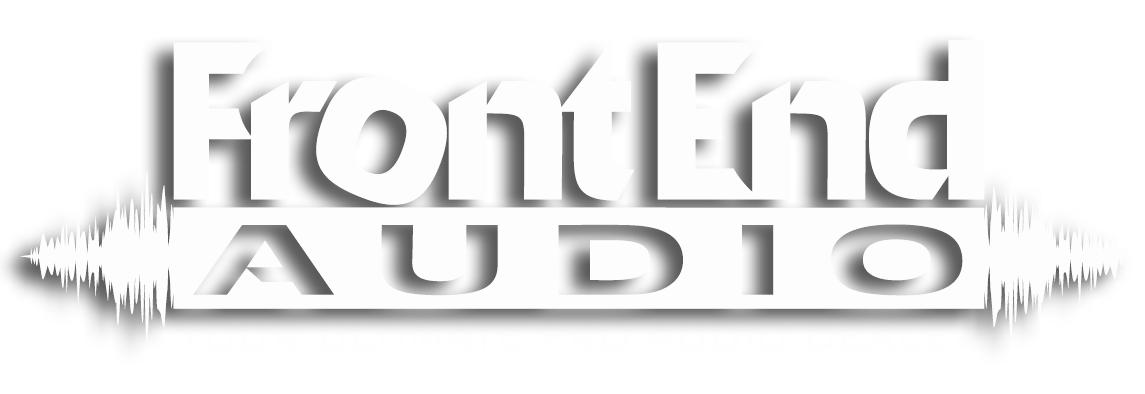


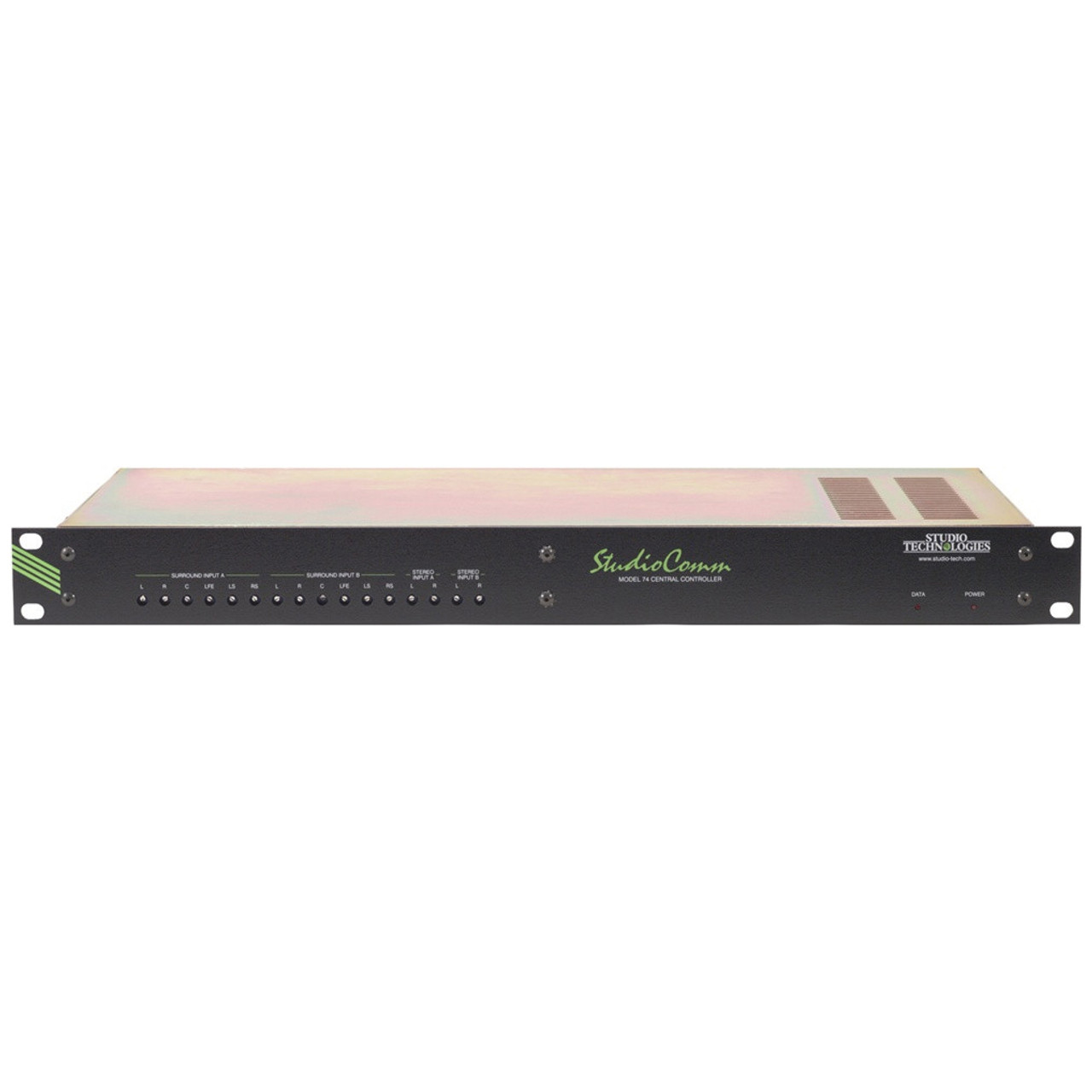





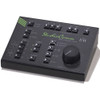

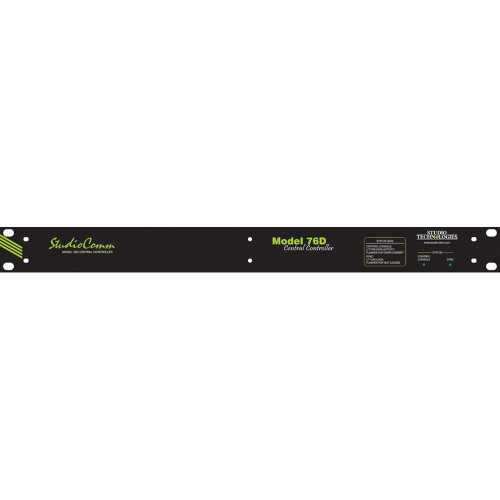




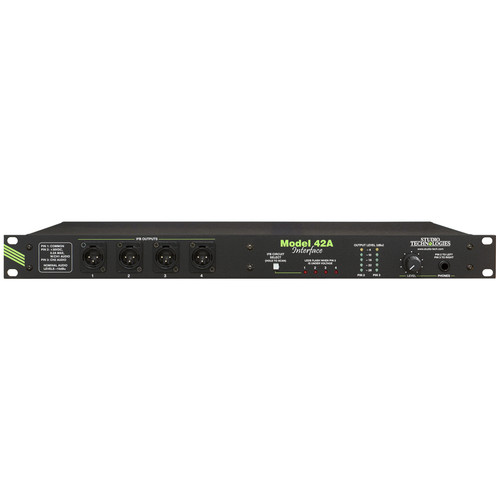




 Sign Up for exclusive sales and offers!
Sign Up for exclusive sales and offers!